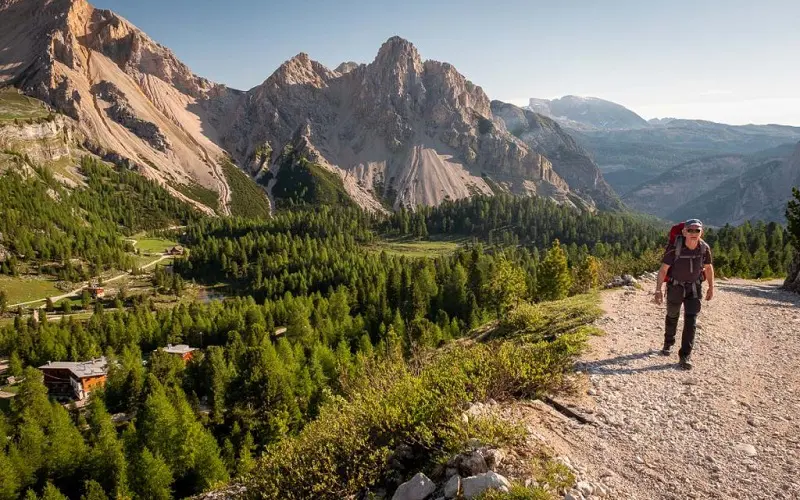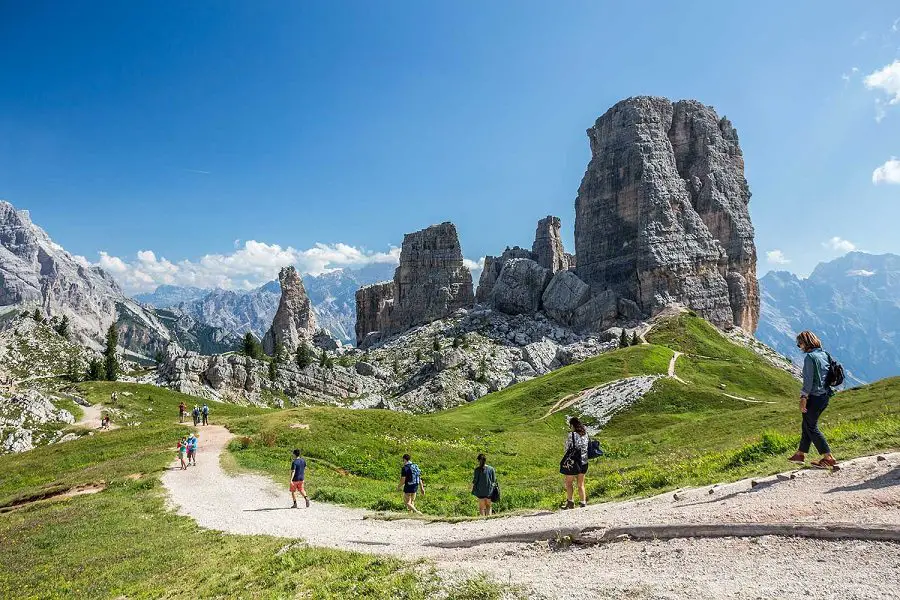SHTFPreparedness may collect a share of sales or other compensation from the links on this page.
Few hiking destinations around the globe leave an impression quite so enduring and utterly endearing as the Italian Dolomites.
The Dolomites, a sub-range of the European Alps, may not reach the lofty heights of the Himalayas, Andes, or even its alpine parent peaks just a few hundred miles to the northeast, but they match any mountain on earth in terms of aesthetic allure, thrill, and the variety of challenges posed to hikers.
In this article, we aim to introduce you to the many marvelous features and facets of the Dolomites, along with our top ten reasons you should choose to hike there.
10 Reasons Why Dolomites Hiking Is Unparalleled
In all honesty, we could have let this list run into the hundreds, but nevertheless, we are sure that the ten below will be more than enough to have you booking your hiking trip to Bel Paese in a hurry.
1. The Alta Via Routes

In total, there are ten alte vie (singular: alta via) routes crisscrossing the vast swathes of mountainous terrain in northern Italy’s Belluno, South Tyrol, and Trentino regions, collectively known as the Dolomites.
Each one has its own character and presents a unique challenge, but all share the common denominator of offering some of the best long-distance trekking on earth.
The epic and ever-grueling Alta Via #2 and the thrilling and challenging Alta Via #4, which throws in a handful of via ferrata routes sure to test the nerves and max out the SD cards of any hiker intrepid enough to take it on, are our pick of the bunch.
2. The History
Few people know that the Italian Dolomites played host to one of the most tragic wars in world history.
World War One’s “White War,” some episodes of which are immortalized in Ernest Hemingway’s novel “A Farewell to Arms,” was responsible for the loss of over one million Italian and Austro-Hungarian lives in the four years that it raged amongst—and often on—the peaks of this fascinating and fabled landscape.
The most impressive museums include Cinque Torri, Lagazuoi (one of very few museums, surely, that requires climbing a mountain as part of the cost of entry), Arraba, and the Messner Mountain Museum in Bolzano.
However, on the trails themselves, remnants of the war remain to this day. These include old via Ferrata routes, gunning stations, tunnels blasted out of the mountainsides, high-altitude barracks, and even the occasional bullet shell lying where it fell over a century ago.
3. The Via Ferrata Routes
Around the world, mountainous regions have installed hundreds of via ferrata routes in the last few decades.
However, it is the Italian Dolomites that can be traced to their rather tragic beginnings.
After the war, regular, recreational mountain-goers began to use the leftover chains, bolts, and wires that WWI troops had originally used to reach outposts and gunning stations high in the Dolomites.
In the early 21st century, via Ferrata has become a distinct sport, with the Dolomites offering hundreds of thrilling routes suitable for hikers of all skill levels.
4. The Food
Italy is renowned worldwide for its denizens’ ability to knock out the odd plate or two of incredibly tasty nosh, and in the Dolomites, the very moreish cuisine that sends tourists in droves to other locations around the country is no less delicious but comes with a hearty and wholesome alpine twist.
Some of the delights your palate can expect to encounter not only in the valleys but also in the mountain huts include casunziei (spinach-stuffed ravioli), tris di canederli (a type of dumpling filled with smoked ham and dished up in a steaming broth), cured meats, truffle tagliatelle, blueberry venison, and the tastiest apple strudel anywhere in the world.
To anyone who happens to return home without an extra pound or two than they left with—despite all that trekking—we salute you!
5. The Lakes
The Dolomites, like gems in a giant crown, are dotted with dozens upon dozens of strikingly colored alpine lakes that provide a very photogenic foreground to the background of all the towering mountains.
And they aren’t just good to look at, with most of them offering the perfect spot for a dip at the end of a tough day on the trails or even a bit of boating or kayaking.
Our pick of the bunch are the sumptuous Lago di Braies—reputed to be the gate to the underworld of a local deity but resembling more a portal to paradise—and the emerald-green Lago di Misurina, where you’ll find a handful of campsites and hotels along the shores and enough views to keep you occupied until you next hit the trails.
6. The Very Doable 10,000-Foot Peaks
The Dolomites are home to a host of mountains that are well within the capabilities of most moderately fit hikers.
With such giants as Marmolada (at 10, 968 ft, the Dolomites’ highest mountain), Monte Civetta (10,564 ft), Antelao (10,709 ft), and Tofane di Mezzo (10,643 ft), all are very doable, and only Marmolada requires any proficiency with mountaineering equipment in the summer month
7. The Mountain Huts
The Dolomites boast a network of mountain huts (rifugi (plural) or rifugio (singular) in Italian) that are without peer in the world.
Many of them are located in the most dramatic and breathtaking spots you’re ever likely to come across.
They are known for their tasty food, friendly staff, and their ability to conveniently break up long-distance routes at regular, manageable intervals.
Our favorites are those at Piz Arlara, Rifugio Nuvolau, and the historic Rifugio Locatelli, which serve as the perfect basecamp for those wanting to explore or just kick back and gawp at the iconic Tre Cime di Lavaredo.
8. The Tre Cime di Lavaredo
If visitors to the Dolomites only managed to take in one notable sight during their trip, and that sight happened to be the Tre Cime di Lavaredo (“The Three Peaks of Lavaredo”), they’d be leaving for home happily convinced that their trip was still well worth it.
If you haven’t heard of these striking, outlandishly unique peaks, there’s every chance you’ve seen them, as the Tre Cime happen to be among the most photographed peaks in the world and the most iconic in Europe, and for a good reason.
Rising sharply out of the boulder-strewn Lavaredo altiplano, this trio of russet spires are the type of natural phenomena that deserve every clichéd description imaginable—breathtaking, awe-inspiring, jaw-dropping, surreal, sublime—and probably warrant a few neologisms all their own, such is their utterly singular shape.
You can easily access the Tre Cime by hiking for three hours from Lago di Misurina, or by directly driving or taking a bus to Rifugio Auronzo, located directly below the towering Cima Centrale, the largest of the three peaks.
9. Cortina d’Ampezzo
Cortina d’Ampezzo is to the Italian Dolomites what Aspen is to the Rockies—the playground of the rich and famous but also a vibrant hub for all kinds of high-altitude high jinks: skiing, snowboarding, skydiving, paragliding, kayaking, rock climbing, via ferrata, and, of course, hiking!
Cortina, located in the heart of the Sexten Dolomites, is the perfect base for some R&R after your forays into the surrounding mountains, and about as scenic a stopover as they come between time on the trails.
10. Alpenglow
The alpenglow phenomenon has wowed hikers, mountaineers, photographers, and everyday observers for, we imagine, as long as humans have roamed the earth.
When the sun dips below the horizon, light reflects off of airborne precipitation, ice crystals, or particulates in the lower atmosphere, turning the opposing mountainsides a fiery, opal pink.
The composition of the dolomite rock in the Dolomites, which can appear to change from white to beige to pale gray to coral pink in the course of a single day, amplifies the effect before adding the extra magic of these emblematic and wondrously extravagant displays at sunrise and sunset.
Wrap-Up
Unique, otherworldly, and utterly unforgettable, the Italian Dolomites are a range of mountains that every hiker with an appetite for exhilarating trails and the aesthetically astounding should experience at least once in their lifetime.
















